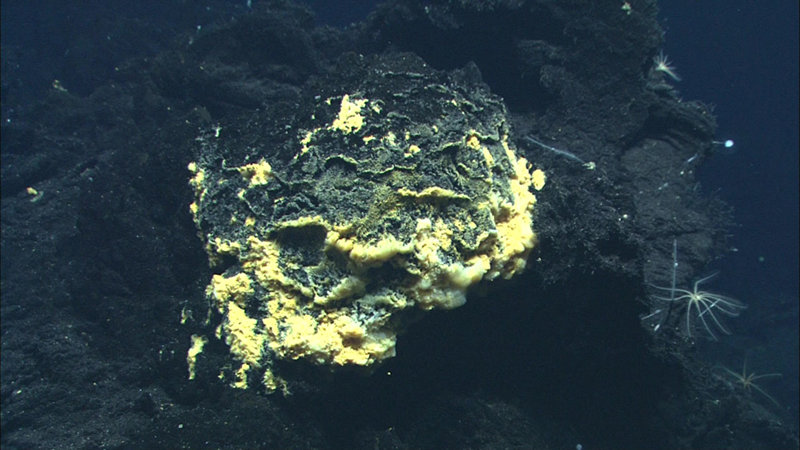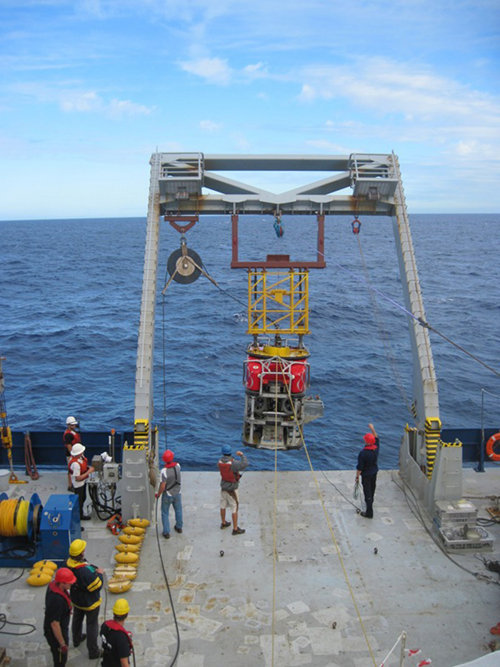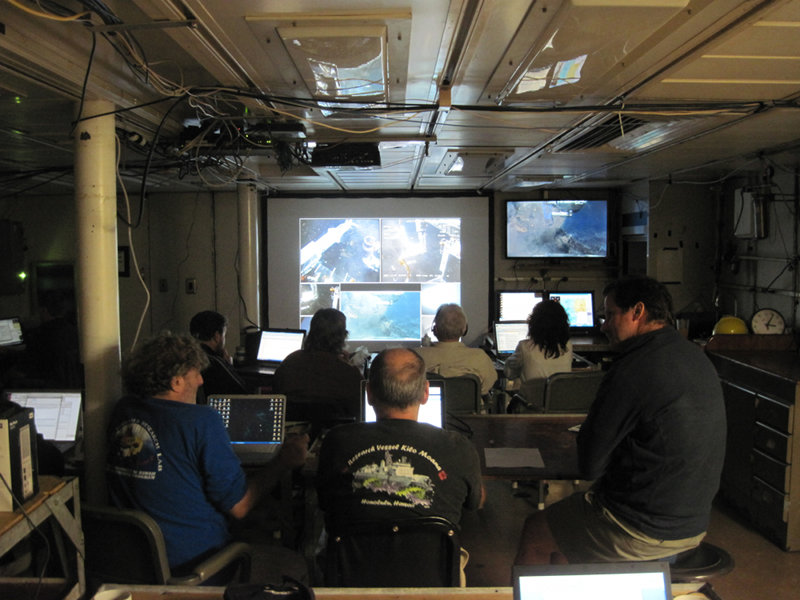
By Paula Keener, Marine Biologist - Director, Education Programs, NOAA Ocean Exploration & Research
September 11, 2012
0638 GMT
Wind – ESE @ 8 kts
Air Temperature – 21.2°C (70.2°F)
Sea State – 3.5m
The R/V Roger Revelle arrived at the first exploration target, Vai Lili, in the early morning hours of September 11, 2012, with the science team looking forward to exploring bacterial mats and collecting samples from hydrothermal vents at this vent field located on the central Valu Fa Ridge in the Lau Basin. The ROV team seemingly executed their mission effortlessly as the Quest 4000 was gently lowered over the stern of the ship, arriving on the seafloor 2 hours later at a depth of 1,741 m (5,710 ft). The first site consisted of what appeared to be lava outcrops covered by sediment, with coral whips, several galathaeid crabs, shrimp, a few branching corals, and at times, hundreds of small jellies in the water column just above the seafloor. Small organisms that were unidentifiable swam in and out of the field of view.

Bacterial mat lies on top of rock structure at Vai Lili. Image courtesy of MARUM, University of Bremen and NOAA-Pacific Marine Environmental Laboratory. Download larger version (jpg, 1.1 MB).
After approximately 40 minutes of bottom time, orange material, which is iron oxide encrusted microbial mats and minerals, came into the field of view of the ROV. It is oftentimes difficult to visually discern the difference between black basaltic/silicic rock and iron and manganese-encrusted mats. “Texas Scoops“ and “Double Scoops“ were used for sampling the bacterial mats at Vai Lili. Both “scoops“ were held by the manipulator claw of the ROV as they literally “scooped“ up samples of the microbial mats. Fifty minutes after reaching the bottom, the first sample of mat had successfully been collected with a “Texas Scoop“.

The University of Bremen-based Quest 4000 ROV team lowers the vehicle over the stern of the R/V Roger Revelle for its first dive of the expedition. Image courtesy of Submarine Ring of Fire 2012: Northeast Lau Basin, NOAA-OER. Download image (jpg, 90 KB).
The second sample area at Vai Lili was also very productive for sampling, with many orange mounds of microbial mats emitting shimmering water, indicating that each mound was likely a separate venting site. The third sampling area showed a region of more focused venting than the previous two areas, and what appeared to be light yellow filamentous mats characteristic of filamentous and stalked iron-oxidizing microorganisms in marine environments. After a further survey of the area, the fourth and final sampling occurred near the region where the first sample was collected, where the iron and manganese samples had a very crusty surface with a great deal of flocculent material underneath. As the final samples were loaded into the collection box, graduate student Rick Davis, a member of the team led by Dr. Brad Tebo from the Oregon Health & Science University, remarked over the ROV Control Van intercom system, “This is exactly what we were looking for…this is just great!“

Scientists watch video in real time sent from Quest 4000 to the Video Viewing Lab on the R/V Roger Revelle. Image courtesy of Submarine Ring of Fire 2012: Northeast Lau Basin, NOAA-OER. Download larger version (jpg, 3.9 MB).
At 0720 GMT (2020 local), the Quest 4000 was secured on board and samples unloaded as scientists anxiously retrieved their samples. For the next several hours, samples will be preserved and/or processed. The well-orchestrated activities carried out today clearly demonstrated the need for an interdisciplinary team of scientists and crew at sea to accomplish what can take years of planning to execute. The exploration goals of Dr. Brad Tebo’s group to obtain samples of unusual microbial mats at this site using specialized samplers developed at his lab at the Oregon Health & Science University have been met. These unusually thick mats, containing alternating layers rich in iron and manganese, will be used to examine the microbial communities collected today with new sophisticated genomic techniques.